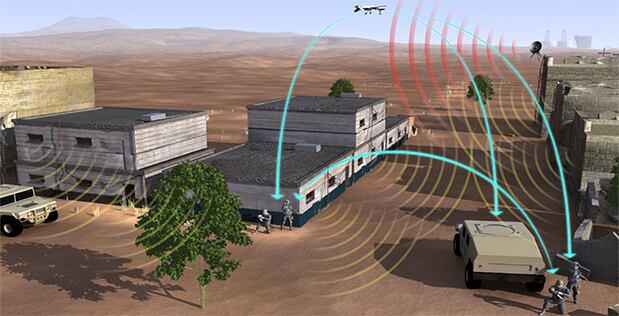While all military services are working to operationalize the cyber domain through the joint Cyber Command, its mission force and respective service cyber components, the Army is working to operationalize the electromagnetic spectrum and similar disciplines.
With the creation of a new cyber directorate at the Pentagon, which fuses cyber, electromagnetic and spectrum activities, the Army is trying to position itself from an operational, training, acquisition and planning perspective.
"If you look at how you allocate the spectrum for either friendly use or using as unfriendly use against our adversaries, when you’re looking at the cyber itself and the connectivity of all those electronic networks, there’s just a natural nexus between them," Jennifer Napper, who formerly served as the director of policy, plans and partnerships for Cyber Command and commander of the Army’s Network Enterprise Technology Command, said in an August interviewregarding the new cyber directorate.
Keeping the directorate within the G-3 will help inform and integrate operations, Napper said, since cyberspace operations are not performed in a vacuum, but as part of a larger plan.
"I think it has to be folded into [cyber] because if you look at what we’re really talking about, [it's] moving information of some sort or moving data of some sort, and the electromagnetic spectrum just happens to exist. It is the physics behind what we’re doing, but I don’t think it’s a separate domain," she said.
"How do we bring this CEMA doctrine to life?" Brig. Gen. Patricia Frost, the Cyber directorate’s director asked Dec. 1 at the Association of Old Crows annual symposium in Washington. "I was charged by the G-3 of the Army when I came in to operationalize CEMA. But CEMA — cyber and electromagnetic activity — touches many things. So what capabilities are we going to provide at the tactical edge, how does that integrate ... and how do we operationalize this?
"We recognize that in the Army as a service, we need to reorganize the force structure that we have, and we need to bring together that electronic support and those forces that actually bring electronic support capabilities that aren’t going to be pure just EW," Frost said. "That crosses so many functional areas — the integration of that. So how do we organize some of our electronic warfare soldiers and officers to actually have operational capability that would then integrate across many of the other warfighting capabilities?"
Frost explained that the Army is looking to create a new career field and operational detachment specifically for electromagnetic operations.
"Effective 1 October 2018, our electronic warfare force, which we call our 29 series career field, will now become 17s, meaning that is the career field that is the baseline of cyber," she said. "We will start training the 29 series this year with a foundation in cyber, signals intelligence and electronic warfare. And then we’ll talk about kind of where the Army’s going with reorganization and operational capability."
Frost described this as "really critical" when looking at the foundational needs in this operational space considering there will certainly be blurred lines.
"There will be some things that will be purely a cyber operation, other things that will truly be RF, electronic warfare and there will be things that will be enabled by both and we need to understand that," she said. "So you can’t just be training soldiers, officers, warrant officers and civilians to just be cyber in one specific area," she said.
The new operational detachment, Frost said, is targeted to come online within the next year. As part of this effort, Frost is working with Army Cyber Command, Forces Command and the Cyber Center of Excellence at Fort Gordon, Georgia, to see what might be achievable in this space in five years — an aggressive timeline, but achievable one, Frost contended.
"As we progress … how do you enable this intel/EW enterprise with the emerging cyber mission force?" she said. "Let’s let the cyber mission force continue on its path; we will learn from them and recognize that we will bring this together," she said.
This is a realistic timeline given what is coming from the secretary of the Army, the chief of staff of the Army and those in theater, she added, but noted there must be the right organizational structure and training in place, as well as an understanding of how this will be deployed.
"Now we’re looking at timelines: How do we actually get to achieving that objective and having the organization and people and training by this summer?" she said, adding she is not as concerned about the materiel.
"So we’re working on that doctrine, we’re working on the organization because as I said before, that cyber mission force, that has a very operational, strategic mission set; we did not build the cyber mission forces down at the tactical edge, and we need to reorganize the electronic warfare force that we have today," said Frost.
From a joint, and potentially more hypothetical, perspective, Brig. Gen. Edward Sauley, deputy director of operation for Joint Electromagnetic Spectrum Operations and the mobilization assistant to the director of operations for Strategic Command, offered his thoughts regarding how the elevation of Cyber Command to a full unified combatant commandmight affect operational responsibilities of electronic warfare and cyber.
In the short term, he said, clarifying he is speaking only for himself, the mission for electronic warfare rightfully rests with STRATCOM — which has a global perspective — and is focused on integrating space and cyber effects, EW effects. "Once you break CYBERCOM off, in the short time, I don’t see movement of the EW mission, I think it will stay in STRATCOM," he told an audience at the AOC symposium.
In the long term, 20 years or so, he said, he could see this mission migrating to CYBERCOM. But it’s still early, he said, and CYBERCOM is still building capability toward the cyber mission.
Mark Pomerleau is a reporter for C4ISRNET, covering information warfare and cyberspace.







